Early to Middle Medieval Period
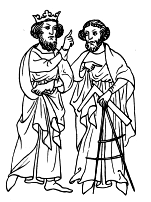 The early medieval period is characterized by relatively
simple shapes, with decoration chiefly being in the form of woven and block printed fabrics. Men
typically wore at least two layers; the outer garment would be shorter and have shorter sleeves, and
would be more heavily decorated at the hem, neck and cuffs, and potentially at the middle arm and in
a second row above the hem. The shape of each garment was essentially a T, with the arms sticking
straight out from the shoulders, and with little shape to the waist - a belt was always worn to
control the fullness of the garment. Under it, men ordinarily wore very loose trousers, tied closely around
the legs, with the lacing in an x-pattern known as "cross-gartering."
The early medieval period is characterized by relatively
simple shapes, with decoration chiefly being in the form of woven and block printed fabrics. Men
typically wore at least two layers; the outer garment would be shorter and have shorter sleeves, and
would be more heavily decorated at the hem, neck and cuffs, and potentially at the middle arm and in
a second row above the hem. The shape of each garment was essentially a T, with the arms sticking
straight out from the shoulders, and with little shape to the waist - a belt was always worn to
control the fullness of the garment. Under it, men ordinarily wore very loose trousers, tied closely around
the legs, with the lacing in an x-pattern known as "cross-gartering."
Later in the period, men began to shape their clothing with the addition of triangular pieces of fabric (gores), inserted in the sides of the tunics at the armholes or waist to make the line of the tunic flare outward. Clothing had very little in the way of fastenings, being mainly pulled over the head, but in about the 12th century, men began to lace the sides of their long tunics tighter across the middle, to produce a more form-fitting silhouette. While they did not use any sort of body binding, as some have surmised that women might, a slender waist was still fashionable, and every effort was made to accentuate it.
Very long undertunic sleeves were fashionable, often being made long enough to extend right over the hand. To enable the use of the hands, sleeves were made tight enough that the wrists would not slide over the hands, but instead force the fabric to wrinkle and bunch along the forearm, creating a fairly narrow silhouette that was not binding or constrictive. The overtunic sleeves gradually grew longer, and then wider as they began to approach the wrist. Soon the characteristic shape of the outer sleeve became a normal width until the middle of the forearm, where it widened out into a bell or trumpet shape that could be as wide as three or four feet.
Coarsely woven hose were also worn on the legs, usually held up by garters or ties. Shoes remained fairly functional, although pointed toes began to become fashionable in the 13th century.
Hair length varies considerably, as does facial hair. Relatively short hair was favored early on in the period, and men were often cleanshaven. Longer hair does begin to appear as time passes, but it is not elaborately styled in any way. A close-fitting linen cap, tied under the chin, is worn by many older men.
Early Fourteenth Century
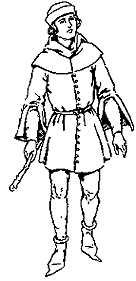
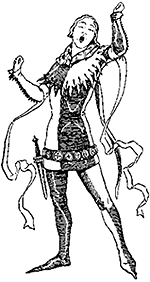 As seamstresses became more sophisticated, the cut and fit of garments improved dramatically. The
signature silhouette of the early 14th century was the cotehardie, a tunic-like garment that was
extremely closely fitted. Fashion began to dictate more strictly the shape of the body, for the dress
was so figure-following that every contour could be revealed - at least to the hips. Cotehardies
for men (for both men and women wore the style) were tightly fitted through to the top of the hips,
using a multitude of buttons at the front and at the wrist, and the skirt either reached the knees or stopped
just below the hips.
As seamstresses became more sophisticated, the cut and fit of garments improved dramatically. The
signature silhouette of the early 14th century was the cotehardie, a tunic-like garment that was
extremely closely fitted. Fashion began to dictate more strictly the shape of the body, for the dress
was so figure-following that every contour could be revealed - at least to the hips. Cotehardies
for men (for both men and women wore the style) were tightly fitted through to the top of the hips,
using a multitude of buttons at the front and at the wrist, and the skirt either reached the knees or stopped
just below the hips.
Belts were still worn by everyone, since there were no pockets in the clothes. As the cotehardie grew more fitted, the belt was no longer worn around the natural waist, but down around the hips, to produce a longer waistline.
Again, an undertunic was worn beneath the cotehardie, also rather closely fitted, but of a lighter material, allowing excess fabric to be crushed to the body in discreet amounts. Also fashionable was the practice of fastening narrow strips of fabric (called tippets) around the upper arm, perhaps as a vestige of the bell-like sleeves of the previous century.
Young, idle men grew their hair over their ears, and curled the ends. Older men and men of lesser social status left their hair shorter and often wore hoods with capelets on the bottom that covered their shoulders. They also eschewed the extremely tight cotehardies for garments with a similar shape but a more forgiving cut. Most remained clean-shaven.
Hose became a bit more form-fitting, but was still held up by garters or ties. The quality of the hose became increasingly apparent as the hemline of the cotehardie crept even farther toward the waist, since only hose were worn beneath the cotehardie. (No pants.) Shoes began to lengthen and point, although not to the lengths that would become fashionable later on.
Later Fourteenth Century - Early Fifteenth Century
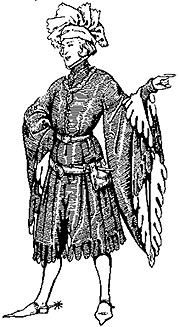 In an age where all your wealth could actually be shown to someone, ostentation of dress became an
increasingly important factor in determining fashion. Around the turn of the century, the culmination
of this principle was the houppelande. Yards and yards of beautiful outer fabric, yards and yards of
beautiful lining fabric (or even fur!), and as much trimming, embroidery and even bells as the
shoulders could support.
In an age where all your wealth could actually be shown to someone, ostentation of dress became an
increasingly important factor in determining fashion. Around the turn of the century, the culmination
of this principle was the houppelande. Yards and yards of beautiful outer fabric, yards and yards of
beautiful lining fabric (or even fur!), and as much trimming, embroidery and even bells as the
shoulders could support.
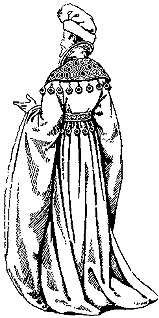 The houppelande is also the last medieval style worn by both sexes. The body of the garment angled sharply
outward from beneath the arms, creating a tent-like mass of fabric that was pleated carefully across
the chest and held in place by a belt. Men's belts returned to the natural waistline or slightly higher, the
better to control all the fabric. Collars were quite high, necessitating an elegant lift of the head.
The houppelande is also the last medieval style worn by both sexes. The body of the garment angled sharply
outward from beneath the arms, creating a tent-like mass of fabric that was pleated carefully across
the chest and held in place by a belt. Men's belts returned to the natural waistline or slightly higher, the
better to control all the fabric. Collars were quite high, necessitating an elegant lift of the head.
The sleeves were loosely fitted to just above the elbow, and then opened out in an enormous bell shape, with the ends of the sleeves frequently dragging on the floor. "Dagging," the fashion of cutting the edges of fabric into intricate repeating shapes, decorated the edges of sleeves, which were usually lined with a contrasting fabric or perhaps with squirrel or ermine.
The undergown could also contrast, and its sleeves were usually closely fitted, although there are some examples of short dagged wrists. Although many houppelandes were just as long as those of the women, gowns that stopped just around the knee were also quite popular. To enable greater ease of movement, houppelandes that were not shortened ordinarily had a slit up the front of the gown to the knee or mid-thigh, enabling the gown to fall open during walking and riding.
To match the extravagance of the gowns, hats grew larger and larger. There were pointy felt hats, fat round turban-like hats, and in an interesting example of reuse, the hood and capelet of the previous fashion became a hat. The edges of the capelet were dagged in interesting patterns, the point of the hood was lengthened to several feet, and the hole for the face became the bottom of the hat. Men put the face-hole over the top of their head, wrapped the point of the hood several times around the head to keep it in place, and let the decorated mass of the cape fabric flop over to one side, producing a sort of cock's-comb effect. To avoid interference with the high collars, men remained clean-shaven.
Hose and shoes remained largely the same as the earlier part of the century, with a continuing gradual extension of the point of the shoe. Pants were not reinstated, except among the poorer classes, for whom the extravagance of the houppelande was wholly impractical (and even impossible!). The fashion of wearing bits of armour began to develop around this time, with spurs being acceptable indoors.
Later Fifteenth Century
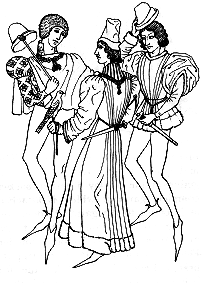 As the century progressed, the penchant for masses of fabric continued, but distributed in a slightly different
manner. The enormous sleeves disappeared, and the bulk of the sleeve moved up to the shoulder, which became
padded and stuffed in such a manner as to appear like large bakery products mounted on either side of the
head.
As the century progressed, the penchant for masses of fabric continued, but distributed in a slightly different
manner. The enormous sleeves disappeared, and the bulk of the sleeve moved up to the shoulder, which became
padded and stuffed in such a manner as to appear like large bakery products mounted on either side of the
head.
Instead of the torso fabric of the houppelande, which was pleated into the belt every time the wearer put it on, the upper portions of the late-century garments were permanently stitched into pleats and padded, so that the chest achieved a very bulky appearance. In the garments of older and more distinguished men, this made the wearer look quite substantial, and gave a pleasing frame for the wide gold chains of rank that many nobility wore draped about their shoulders and across the chest.
However, among many young dandies, the fashion was to crop the skirts of the gown as short as possible - sometimes so short as to rouse the ire of priests, who gve thunderous sermons on the immorality of hemlines that reached the waist. With no balancing long skirts, the stuffed chest and wide sleevecaps balanced on slender legs encased only in tights were quite ridiculous. To add to the exaggerated image, tall, narrow hats that perched on top of tightly curled and styled hair, or stuffed and padded rolls with dangling feathers and ribbons completed the costume. Beards were not normally worn.
Hose became incrementally more close-fitting, and continued to tie to the bottom of the jacket or perhaps to the shirt worn underneath. Shoe points grew to amazing lengths, sometimes becoming so long that it was necessary to fasten the point up in order to walk. Small garters were worn just below the knee, with jeweled chains reaching to the point of the shoe and curling it up.
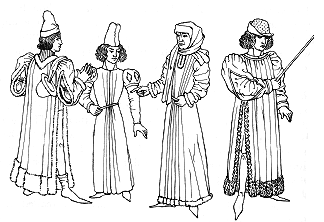
Early Sixteenth Century
The early sixteenth century (called the Tudor period in England) carried on the bulky silhouette of the prevous era, but in a more balanced fashion. As many as four layers comprised a gentleman's costume; a shirt, a doublet, a jerkin, and a coat.
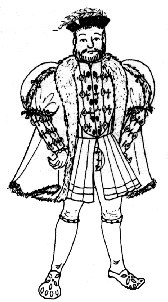 Shirts were made with as fine a fabric as could be obtained; linen
was comfortable, washable, and easily embroidered - a very important consideration, for elaborate
ornamentation became wildly popular. Voluminous sleeves were set onto a full-cut body, with ruffled edges
at collar and cuffs.
Shirts were made with as fine a fabric as could be obtained; linen
was comfortable, washable, and easily embroidered - a very important consideration, for elaborate
ornamentation became wildly popular. Voluminous sleeves were set onto a full-cut body, with ruffled edges
at collar and cuffs.
The doublet began to resemble the modern vest. It extended only to the waist, and could be square-necked to display the fine cloth of the shirt collar, or open down the front and laced closed. It ordinarily had sleeves, which can be tied on at the armhole and therefore made interchangable.
The jerkin, much like a jacket, was the third layer. It was long, with a pleated or gathered skirt that extended to mid-thigh or perhaps to the knees. Sleeves were puffed and bombasted to make a deep melon shape that ended at the elbow, exposing the decorated sleeve of the doublet; these sleeves were also attached by ties, which were hidden under a padded shoulder roll.
The outermost layer, the coat, was a fairly unconstructed full gown, which was at least as long as the jerkin and sometimes longer. It had a deep collar that fell across the back, the width of the shoulders, and then tapered down to the hem at the front. With especially large jerkin sleeves, the coat could be left sleeveless, to show off the resplendent under-sleeves, or fitted with open sleeves that hung behind the arm. The coat was not belted, but left to fall open.
Early in the century, men simply wore tights beneath the closed jerkin, but as the century progressed, the jerkin grew somewhat shorter, and opened in the front, necessitating additional clothing. Short, loosely cut breeches were worn, with a codpiece to join them in the front. The codpiece, originally a fairly inconspicuous item of clothing, was increased in size as the mass of the rest of the garments increased, and eventually began to poke out through the opening in the jerkin.
Heavy jewelry, especially wide gold links, balanced the weight of the garments. Rich fabrics were used, with a preponderance of embroidery, ribbons and trimmings. Men began to wear beards again, and grow then long enough to shape them into squares, forks, and other interesting designs.
Shoes were flat, and square-toed.
Late Sixteenth Century
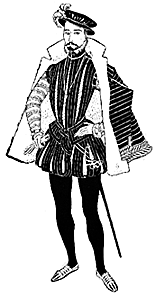
Men's fashion during the latter portion of the century, while still substantial in silhouette, followed some of the same conventions as that of their female couterparts. The torso grew narrow, while the hips became more and more prominent.
The shirt, while still made of the same materials, became less and less visible. The ruffled collar and cuffs developed into separate, starched ruffs that attached to the collar and cuffs of the shirt. There is a period of unrestrained growth of the ruff that culminated in enormous platters of starched fabric that sometimes required special eating utensils in order to reach the mouth. Like all fashion extremes, though, this fashion was taken up somewhat less enthusiastically by more sober gentlemen, who limited themselves to smaller, but by no means, tiny ruffs.
The doublet was lined tightly through the torso to produce a slim waist. In the front, however, it was padded and stuffed to form a "peascod belly" that protruded over the waistline in a clearly artifical manner. The huge sleeves of the earlier period were discarded in favor of a more natural shape that followed the contours of the arm more closely, and fitted quite tightly into the armhole.
A fitted jerkin was sometimes worn over the doublet, but with either open or absent sleeves to reveal the decorated sleeves of the doublet. Another possible outer garment was a short cloak, reaching only to the waist or hips and slung over one shoulder and under the other on a diagonal. The open sleeves or the interior of the cloak would certainly be lined with a complementary fabric.
With the doublet stopping at the waist, breeches continued to be necessary. They could be tightly fitted to the knee, puffed and padded and reaching only to the bottom of the hips, large padded pumpkin-shaped hose, or longer breeches that fastened below the knees and were quite voluminous. The silhouette was either short and closely fitted, showing off the leg, or long and enveloping, creating a triangle-shape.
Hose were worn beneath the breeches, covering the leg, and garters worn at the calf or knee were fashionable. Shoes were still flat, although not quite so square at the front.
Hair was worn quite short, as were beards, since the collars of the doublets and the shirt ruffs were so high. Small, elegant hats, befeathered and jewelled, were worn by the idle classes, while floppier, less ornate hats were worn by the working classes.
The images on this page are designed to give you a quick and clear reference to the distinctive silhouette of each period. There are many, many galleries on the web that can provide a much broader idea of both the variations in styles and also the colours and decorations that enlivened them. For some jumping-off points, consult the Costume Links page.
If you have any questions about this pages or the materials contained therein, please contact Carla Emmons, my most gracious maid of honour.